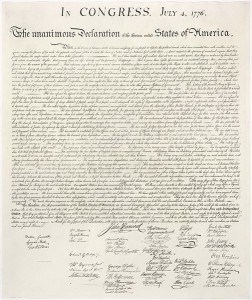Archive for year: 2014
An Open Letter to Our Re-Elected Governor, Nikki Haley
/0 Comments/in Politics/by AJ Design
Dear Governor Haley,
We haven’t met yet, though we almost had a chance when you visited Natty’s on Trinity Street in Abbeville last weekend. I had a birthday party to attend, and when one has the chance to take small kids to Jumping Jax, one just doesn’t decline. Ever. Even for a chance to meet the Governor of South Carolina. (sorry!)
But enough about me. Congrats to you on your re-election as Governor of the Great State of South Carolina! You earned my vote with your principled conservative stance on economic issues, your perspective on the balance of power between states and the federal government, and your refusal to take the baited hook that was the Medicaid expansion. I think your first term in office did most residents of South Carolina proud. There are a few thousand people who will be leaving the unemployment system as a direct result of your administrative priorities. Thank you for your service.
But not everyone is happy with what you’ve done (or not done) so far. I believe there will always be smoke-and-mirrors accusations that come from political opponents. These attacks are rarely more than political maneuvering, and they are rarely fair. However, one such attack caught my eye. I’m referring to the recent trouble with the S.C. Department of Social Services.
One of my acquaintances is a social worker within DSS, and he didn’t have very many kind things to say about you because of the predicament in which he and other DSS workers find themselves. Actually, he and many of his colleagues were quite adamantly opposed to your re-election. They already have a difficult, thankless job. But then they are overworked and underpaid. I’m told the case load and the resources to address it are still sorely mismatched. Let me offer a quote from a social worker who volunteered some information on the matter when I asked about it. Pardon the colorful language:
[DSS State Director Lillian] Koller called for higher standards without backing the requirements with funding or more workers. Or better working conditions. Or more supervision. Children are literally dying because we do not have the resources to keep them safe. I triple dog dare any Republican to come work for Anderson County DSS. Witness firsthand the aftermath of the last four years. Ask any employee what their opinion is. Nikki Haley does not care about children, the elderly, or the poor. To her they are numbers. She makes a big deal about veterans … but there is a war here. [My colleagues] and I go to war every day to fight for the safety of SC’s abused and neglected children. It is f*cking brutal, we get no support. We are sent into dangerous situations with no protection, and all we ask is for lower case loads and better supervision so we can actually do our jobs. Nikki Haley has consistently ignored our requests and the department has deteriorated to the extent that children are dying because the workers are responsible for so many children that kids are just falling through the cracks. Haley is ultimately responsible for what happened at DSS. She made the decisions that led to the chaos.
Ouch.
I read some of your remarks about the deaths that occurred and the condition of DSS which you delivered during a recent debate. As a wife and mother, you seemed to be understandably appalled and disturbed by what happened. To be fair, I would expect a senior executive such as yourself to be more keen on the numbers coming out of DSS than on the individuals and stories that comprise the caseload. And I expect that reality would bother social workers who care about their work. There’s only so much one can do, and the realities of executive leadership dictate that you must necessarily focus on metrics and fundamentals to the exclusion of the human element.
But let me offer some encouragement: now that the gubernatorial election is settled and you are in leadership for another term, please continue to take ownership of the problems within DSS. It’s no longer a campaign issue. It’s now a real-life problem that you have the next 4 years to address with real solutions. Please commit to identifying solutions that will enable the department to function well. I was encouraged to learn from District 11 representative Craig Gagnon that there were some stopgap measures taken earlier this year to increase social worker pay and improve conditions. He tells me there are additional efforts coming in the next legislative session. This is a very good thing. And those transformational efforts will need your executive leadership to ensure their success.
There are a plethora of opinions about the extent to which the government—even state and local governments—should be involved in correcting the social and familial dysfunction that DSS is tasked with addressing. I personally believe you can’t remove Godly principles from a population and not have tremendous problems. Broken families are just a symptom of deeper spiritual problems. So as far as the source the problems that manifest in DSS cases, there’s not much we can do. Can you use the powers of government coerce men to be good and loving fathers? Can you coerce drug addicts to prefer honest gainful employment to a life of addiction? Can you engineer a utopian society? Many have tried, and all efforts to date have failed. But perhaps there are non-government organizations, nonprofits and religious organizations that could be involved in carrying or at least supporting the DSS case load. What can we do to better empower and deploy these resources to help accomplish the goals of DSS? Maybe it would be inadvisable for volunteers from churches to take on cases. Many have the heart but few have the training and expertise. But perhaps a Sunday school class could “adopt” a social worker and provide support and encouragement. We don’t always have to expand government to fix things. You have helped demonstrate that in the past four years. But until the problem is resolved and alternate solutions are in place, I think we will have to fully fund DSS to match their case load.
I encourage you once again to make a priority of fixing the issues at DSS. Continue to set high standards. Install a high-quality, proven director (and I’m sure the search is already underway). Fund the organizations and people best equipped to attain those standards and serve people. Usher in a new era of effectiveness and professionalism. You have the bully pulpit. You have the authority to set the agenda and set priorities. And it looks like you will have plenty of political colleagues and citizens who will support your efforts.
I don’t hold you personally responsible for the hurtful actions of others. We humans are by-and-large hopelessly broken creatures. And goodness knows we don’t need a bigger government peering, prying, and taxing it’s way into every nook and cranny of our lives. But I applaud your efforts to make government more effective and to ensure the most vulnerable among us are offered protection.
Thanks you for listening,
Andy Johnston
True Beauty – Typographic Inspiration
/0 Comments/in Inspiration/by AJ Design
Font: Cezanne from P22 Type Foundry
Improve Communications with Five Less-Is-More Tips
/0 Comments/in Business Friendly Design, Tips/by AJ DesignCommunication is the Lifeblood of Nearly Everything We Do
Whether your goal is to drive sales, educate or inspire, effective communication is at the heart of practically everything you do. If you must work with or through others to get something accomplished, you need effective communication. Speaking well is certainly important, but I want to share with you a few tips that can help you improve your effectiveness in written or visual communication. If you sometimes struggle to write letters, memos or other documents — even ad copy or web content — I think you will find these tips to be helpful.
1. Consider Your Audience … and Limit Your Message Accordingly
The words you may use to connect with 5th graders would be very different from those you might use to address peers in business. We would also communicate differently with entry level employees and the board of directors. A good first step toward improving your communications is to identify your audience. Once you understand clearly the audience you are trying to reach, you can omit communication that is not appropriate.
2. Use Fewer Words
Google provides the definition of brevity as follows:
We may have developed a bad habit of inflating our word count to meet a quota in high school. But brevity is critical for clear communication in business. Use fewer words that convey the same meaning whenever possible.
3. Use Clear Space to Bring Attention to Your Message
Before an orchestra begins, the conductor calls the musicians (and the audience) to silence. Think of words as sound and white space as visual silence. With sufficient silence, you create room for sound — your message. Margins are a simple way to add silence to your content. Another place we find clear space is within images: copy space. Many of the best magazine ads and billboards use images with copy space. Use the silence of clear space to provide a place for the message you intend to convey.
4. Use Clip Art Sparingly If at All
Clip art is rarely necessary. Not all clip art is bad, but some of it is downright awful. If you intend for your message to be light, informal and comedic, clip art may be justified. The problem is that a lot of people seem to use clip art habitually rather than intentionally. Think of the brevity principle. If your message stands alone without clip art, leave it out.
5. Know When to Call a Communications Professional
You may not be an art director or a marketing manager, but small businesses occasionally need the services of a copy writer or a layout artist. Think about the cost associated with a mistake. How many people would be affected? If business is on the line for a print ad, a billboard, or a press release, consider enlisting the services of a trusted professional.
We hope these tips make your communications more effective. If you have specific questions or if your current needs are beyond what you can handle, contact us today online or by phone at (864) 554-5061.
When Is the Last Time You Were Inspired by Marketing in the Financial Sector?
/0 Comments/in Business Friendly Design, Marketing Stratregy/by AJ DesignHave you seen the #TDThanksYou video? Take a look:
Okay, okay…we know that #TDThanksYou is not a charity campaign; it’s a marketing campaign from a for-profit entity. And I’m sure there more than a few people who are a bit creeped out that a bank (or perhaps a bank’s employees in collusion with family members) essentially surveilled a few customers to get the details required to be so personalized with their gifts. And we know that everyone can’t expect to receive the same type of lavish experience at TD Bank.
All of that cerebral, skeptical stuff aside, is this not one of the best marketing tactics ever?! It’s like the best parts of Undercover Boss and Extreme Makeover Home Edition applied to the context of a bank’s relationship to a few of its customers. And here we are, discussing it of our own accord at no cost to TD Bank. It’s so genius, it’s almost evil. Almost. But most people including this humble blog author can’t help but have some degree of positive feelings about TD Bank after watching this video.
This kind of marketing inspires and challenges those of us who make our trade in persuasive communication. Yes, we can tell the story of our clients’ businesses or products and tout their best points. But it takes a special kind of effort and creativity to inspire people in the process of advertising or marketing. The generous nature of the thank-you gifts overwhelms the recipient in the video and many viewers as well. The personalization of the gifts to the situations, challenges, and desires of the recipients is so spot-on, it’s uncanny.
How are YOU (and how am I) being inspirational, generous and personal with YOUR marketing efforts?
Your turn…
What do you think about this video from TD Bank? Do you feel the love, or do you remain unconvinced?
Declaration of Independence: Worth Reading Again and Again
/0 Comments/in Liberty, Politics/by AJ DesignThis post has nothing to do with graphic design or marketing in a direct sense. It’s a bit off topic, so consider yourself warned. It doesn’t even have global applicability. If you are not from the United States, there’s not much here for you. My apologies.
I am amazed at the seeming prevalence of United States citizens who are lacking what I would consider are the most basic of facts concerning the great nation we comprise. For instance, during a campaign cycle, if you encounter a discussion about politics, you’re likely to hear someone wringing their hands about how a particular person or policy just isn’t democratic or fair. Some people apparently don’t realize that the United States is not a pure democracy. Instead, it is a republic (look it up). And when a sitting President is able to brag to the American people about how he is proud to have bypassed Congress, that’s a sign that a lot of people have no concept of the checks and balances built into the executive, legislative, and judicial branches of our government.
Do I categorically defend the antics of a bunch of career politicians in Washington who are generally spinning their wheels, using up good oxygen and spending taxpayer money with abandon and little to show for it? Absolutely not. But it just seems there is no more sense of propriety or idealism concerning our government any more. It as if there’s nothing to live for in the political sphere. Where’s the conviction? Where’s the statesmanship that cares more about the next generation than the next election?
My annual tradition concerning the Independence Day holiday is to read the Declaration of Independence in its entirety. I’m always awestruck with the restraint and forbearance of the writers of the Declaration. Yes, they had some grievances with King George that were arguably petty, especially when one considers the scope and scale of our do-everything-for-you Federal government in 2014. But by all modern standards, the people living in the colonies had endured “a long train of abuses and usurpations” under the British Crown. I wonder, “Would I have acted with such restraint under the same pressure?” I like to think so, but I’m not sure I’ll ever know. Let’s hope not anyway. But these responses to such a seminal document are important. They awaken us to the desperate circumstances of our national origins. The spirit and resolve of the writers of the Declaration call out to us today. It is worth reading.
So here, in all it’s glory, I invite you to read the Declaration with me. I am presenting it below, copied from the U.S. National Archives and Records Administration site for your convenience and enlightenment. A complete transcript, including the signatures, appears below. You also may appreciate viewing a scan of the document. Click here for a high resolution image.
IN CONGRESS, July 4, 1776.
The unanimous Declaration of the thirteen united States of America,
When in the Course of human events, it becomes necessary for one people to dissolve the political bands which have connected them with another, and to assume among the powers of the earth, the separate and equal station to which the Laws of Nature and of Nature’s God entitle them, a decent respect to the opinions of mankind requires that they should declare the causes which impel them to the separation.
We hold these truths to be self-evident, that all men are created equal, that they are endowed by their Creator with certain unalienable Rights, that among these are Life, Liberty and the pursuit of Happiness.–That to secure these rights, Governments are instituted among Men, deriving their just powers from the consent of the governed, –That whenever any Form of Government becomes destructive of these ends, it is the Right of the People to alter or to abolish it, and to institute new Government, laying its foundation on such principles and organizing its powers in such form, as to them shall seem most likely to effect their Safety and Happiness. Prudence, indeed, will dictate that Governments long established should not be changed for light and transient causes; and accordingly all experience hath shewn, that mankind are more disposed to suffer, while evils are sufferable, than to right themselves by abolishing the forms to which they are accustomed. But when a long train of abuses and usurpations, pursuing invariably the same Object evinces a design to reduce them under absolute Despotism, it is their right, it is their duty, to throw off such Government, and to provide new Guards for their future security.–Such has been the patient sufferance of these Colonies; and such is now the necessity which constrains them to alter their former Systems of Government. The history of the present King of Great Britain is a history of repeated injuries and usurpations, all having in direct object the establishment of an absolute Tyranny over these States. To prove this, let Facts be submitted to a candid world.
- He has refused his Assent to Laws, the most wholesome and necessary for the public good.
- He has forbidden his Governors to pass Laws of immediate and pressing importance, unless suspended in their operation till his Assent should be obtained; and when so suspended, he has utterly neglected to attend to them.
- He has refused to pass other Laws for the accommodation of large districts of people, unless those people would relinquish the right of Representation in the Legislature, a right inestimable to them and formidable to tyrants only.
- He has called together legislative bodies at places unusual, uncomfortable, and distant from the depository of their public Records, for the sole purpose of fatiguing them into compliance with his measures.
- He has dissolved Representative Houses repeatedly, for opposing with manly firmness his invasions on the rights of the people.
- He has refused for a long time, after such dissolutions, to cause others to be elected; whereby the Legislative powers, incapable of Annihilation, have returned to the People at large for their exercise; the State remaining in the mean time exposed to all the dangers of invasion from without, and convulsions within.
- He has endeavoured to prevent the population of these States; for that purpose obstructing the Laws for Naturalization of Foreigners; refusing to pass others to encourage their migrations hither, and raising the conditions of new Appropriations of Lands.
- He has obstructed the Administration of Justice, by refusing his Assent to Laws for establishing Judiciary powers.
- He has made Judges dependent on his Will alone, for the tenure of their offices, and the amount and payment of their salaries.
- He has erected a multitude of New Offices, and sent hither swarms of Officers to harrass our people, and eat out their substance.
- He has kept among us, in times of peace, Standing Armies without the Consent of our legislatures.
- He has affected to render the Military independent of and superior to the Civil power.
- He has combined with others to subject us to a jurisdiction foreign to our constitution, and unacknowledged by our laws; giving his Assent to their Acts of pretended Legislation:
- For Quartering large bodies of armed troops among us:
- For protecting them, by a mock Trial, from punishment for any Murders which they should commit on the Inhabitants of these States:
- For cutting off our Trade with all parts of the world:
- For imposing Taxes on us without our Consent:
- For depriving us in many cases, of the benefits of Trial by Jury:
- For transporting us beyond Seas to be tried for pretended offences
- For abolishing the free System of English Laws in a neighbouring Province, establishing therein an Arbitrary government, and enlarging its Boundaries so as to render it at once an example and fit instrument for introducing the same absolute rule into these Colonies:
- For taking away our Charters, abolishing our most valuable Laws, and altering fundamentally the Forms of our Governments:
- For suspending our own Legislatures, and declaring themselves invested with power to legislate for us in all cases whatsoever.
- He has abdicated Government here, by declaring us out of his Protection and waging War against us.
- He has plundered our seas, ravaged our Coasts, burnt our towns, and destroyed the lives of our people.
- He is at this time transporting large Armies of foreign Mercenaries to compleat the works of death, desolation and tyranny, already begun with circumstances of Cruelty & perfidy scarcely paralleled in the most barbarous ages, and totally unworthy the Head of a civilized nation.
- He has constrained our fellow Citizens taken Captive on the high Seas to bear Arms against their Country, to become the executioners of their friends and Brethren, or to fall themselves by their Hands.
- He has excited domestic insurrections amongst us, and has endeavoured to bring on the inhabitants of our frontiers, the merciless Indian Savages, whose known rule of warfare, is an undistinguished destruction of all ages, sexes and conditions.
In every stage of these Oppressions We have Petitioned for Redress in the most humble terms: Our repeated Petitions have been answered only by repeated injury. A Prince whose character is thus marked by every act which may define a Tyrant, is unfit to be the ruler of a free people.
Nor have We been wanting in attentions to our Brittish brethren. We have warned them from time to time of attempts by their legislature to extend an unwarrantable jurisdiction over us. We have reminded them of the circumstances of our emigration and settlement here. We have appealed to their native justice and magnanimity, and we have conjured them by the ties of our common kindred to disavow these usurpations, which, would inevitably interrupt our connections and correspondence. They too have been deaf to the voice of justice and of consanguinity. We must, therefore, acquiesce in the necessity, which denounces our Separation, and hold them, as we hold the rest of mankind, Enemies in War, in Peace Friends.
We, therefore, the Representatives of the united States of America, in General Congress, Assembled, appealing to the Supreme Judge of the world for the rectitude of our intentions, do, in the Name, and by Authority of the good People of these Colonies, solemnly publish and declare, That these United Colonies are, and of Right ought to be Free and Independent States; that they are Absolved from all Allegiance to the British Crown, and that all political connection between them and the State of Great Britain, is and ought to be totally dissolved; and that as Free and Independent States, they have full Power to levy War, conclude Peace, contract Alliances, establish Commerce, and to do all other Acts and Things which Independent States may of right do. And for the support of this Declaration, with a firm reliance on the protection of divine Providence, we mutually pledge to each other our Lives, our Fortunes and our sacred Honor.
The 56 signatures on the Declaration appear in the positions indicated:
Column 1
Georgia:
Button Gwinnett
Lyman Hall
George Walton
Column 2
North Carolina:
William Hooper
Joseph Hewes
John Penn
South Carolina:
Edward Rutledge
Thomas Heyward, Jr.
Thomas Lynch, Jr.
Arthur Middleton
Column 3
Massachusetts:
John Hancock
Maryland:
Samuel Chase
William Paca
Thomas Stone
Charles Carroll of Carrollton
Virginia:
George Wythe
Richard Henry Lee
Thomas Jefferson
Benjamin Harrison
Thomas Nelson, Jr.
Francis Lightfoot Lee
Carter Braxton
Column 4
Pennsylvania:
Robert Morris
Benjamin Rush
Benjamin Franklin
John Morton
George Clymer
James Smith
George Taylor
James Wilson
George Ross
Delaware:
Caesar Rodney
George Read
Thomas McKean
Column 5
New York:
William Floyd
Philip Livingston
Francis Lewis
Lewis Morris
New Jersey:
Richard Stockton
John Witherspoon
Francis Hopkinson
John Hart
Abraham Clark
Column 6
New Hampshire:
Josiah Bartlett
William Whipple
Massachusetts:
Samuel Adams
John Adams
Robert Treat Paine
Elbridge Gerry
Rhode Island:
Stephen Hopkins
William Ellery
Connecticut:
Roger Sherman
Samuel Huntington
William Williams
Oliver Wolcott
New Hampshire:
Matthew Thornton
I thank God there were men and women who took the responsibility seriously and pledged their lives, fortunes, and sacred honor to give birth to the Nation we enjoy today. May God bless this nation and grant us the repentance required to take responsibility for what we possess.
Adobe Creative Cloud 2014 Splash Screens
/24 Comments/in News/by AJ DesignNOTE: On October 6, 2014, Adobe updated the splash screens again. I personally will miss the lion on the Illustrator splash screen, but I think many users will find the updates to be a welcome change.
For better or for worse, Adobe just released a major update to the Creative Cloud suite of applications. The jury is still out on whether the update is an improvement or a nuisance, but for the time being, we have some new splash screens to enjoy upon launching the updated apps.
Love ’em? Hate ’em? Comment below!
Photoshop CC 2014 Splash Screen
Illustrator CC 2014 Splash Screen
InDesign CC 2014 Splash Screen
Premiere Pro CC 2014 Splash Screen
After Effects CC 2014 Splash Screen
Dreamweaver CC 2014 Splash Screen
Muse CC 2014 Splash Screen
Flash CC 2014 Splash Screen
Audition CC 2014 Splash Screen
InCopy CC 2014 Splash Screen
Prelude CC 2014 Splash Screen
SpeedGrade CC 2014 Splash Screen
Bad Design Done Better: Use Fonts Correctly
/1 Comment/in Bad Design Done Better/by AJ DesignA New Sign for a New Neighborhood
There is a newly developed neighborhood not too far from my home. (Note that we don’t have gated communities in Abbeville, SC; this is just a regular ol’ neighborhood — with no gate.) I was somewhat excited when I saw construction begin on the stately entrance and the sign. “This is going to be nice,” I thought. I was in for a rude awakening when the name was applied to the sign:
I was underwhelmed, to put it mildly. The crown and the flourish typesorts were very good. The colors are fantastic and conceptually appropriate. But the typeface choice of ALL CAPS blackletter? I was dismayed.
About Blackletter Type
Blackletter typefaces were built to mimic hand-drawn manuscript lettering from the era when Gutenberg developed the printing press. Blackletter fonts are widely available on many computer systems and have been for years. A common blackletter font option for Windows users is Old English.
You may not be able to put your finger on why this typeface is not the best choice. In fact, the type family itself isn’t bad. But blackletter fonts are incredibly hard to read when presented in all caps. It’s just not done, and this CAMELOT sign presents one supporting example of that fact. Another detail that will grate typography purists is that the characters were stretched vertically.
Better Ways to “Dress” Camelot
First of all, it is completely understandable that the developer wanted to evoke the nobility and romance of Camelot. The name choice is admirable, even if it is just a neighborhood and not a proper gated community. But in my opinion, the sign artist could have done a couple of things differently to yield a much better result.
1. Use All Caps Without Distorting the Characters
It seems the sign maker and the type designer may not have been on the same page. The aspect ratio of the sign was set. And the name layout appears to have been done independently of the aspect ratio. Also, the person ordering or designing the sign must have been afraid of clear space. Simply adding “CAMELOT” in all caps would result in a name that was wide and left a lot of empty space above and below. I’m still not sure that’s a bad thing, but the designer or signmaker solved this “problem” by stretching the characters so the word had a taller aspect ratio that better filled the space.
Type developers, whether from decades ago or in more recent times, devote hundreds of hours to crafting typefaces with the right proportions, shapes, kerning, tracking, weight, etc. If you think it is easy to design a typeface, you are mistaken. There are graphic designers and artists, and then there are type developers. I’m convinced type developers are a different breed altogether.
Rather than thinking, “I know better. Let me just stretch this to fit my space,” a wiser decision would be to simply use the characters as presented in the font without distorting them. If the decision maker was adamant about a blackface font in all caps, the best way to display that would have been to place the characters centered in the space without distorting them:
2. Use Title Case for Blackletter Type
Jacob Cass of JUST™ Creative produced a brilliant type classification ebook which he generously offers for free on his site. On page 17, Cass explains a nuance of handling Blackletter type:
Text type faces should fit snugly together with less space between the words than is customary with normal Roman types and, because of their complex structure, [blackletter type] should never be set in all-capital form.
*emphasis mine
If the CAMELOT sign designer had come across this ebook and had better instruction on handling blackletter type, he might have made a sign that looked something like this:
 3. Consider Small Caps
3. Consider Small Caps
If the goal was a majestic look that evoked the era of Camelot, then Trajan might have been a nice choice. This distinguished font is often used on movie posters (over-used if you ask some folks). But in this context, I think Trajan might be appropriate. What do you think?
They might even have considered another serif font like Garamond. This example is set in small caps, and the tracking is expanded to 120:
Conclusion
The CAMELOT sign is a lovely concept with beautiful colors, and I hope the housing development does well. But I can bet you that if there are any graphic designers or type developers who make their home there and have to drive by that sign every day, they will probably cringe a little until they stop noticing it.
Is PicMonkey a Tool or a Toy?
/10 Comments/in News, Tutorials/by AJ DesignA friend of mine aspires to launch a photography business. She has been learning composition and lighting from an established photographer. She has already done some portraits, and she had been booked for a wedding. We were “talking shop” about cameras, lenses, and editing. She mentioned she uses PicMonkey for editing. I wasn’t familiar with PicMonkey initially, but my first instinct was that a pro-oriented tool like Photoshop would be a better choice for a professional result. That is just my default recommendation based on the axiom that you usually get what you pay for. However, I knew I was ignorant of PicMonkey.
I’m not a fan of ignorance, and I don’t want to rest on my own assumptions, especially if my assumptions would lead me to pay for Photoshop if it were not uniquely necessary and powerful. I started Googling to find out more. The initial results I found were quite warm toward PicMonkey, but they seemed a little suspicious to me. I came across articles with titles like these:
PicMonkey: Photoshop for Broke People
Making Professional Looking Pictures Using PicMonkey
Don’t Want to Learn Photoshop? Use PicMonkey Instead!
Those aren’t the actual article titles I found, but you get the idea. The sentiment from those articles was that photographers and designers who want to save a buck can use PicMonkey and avoid purchasing Photoshop. I didn’t dig too far, but I didn’t find anything overly critical of PicMonkey. My “too good to be true” alarm started going off. I wanted to explore both sides of the issue, so I posted questions on social media to get some feedback from friends. Much to my surprise, the official Twitter account for PicMonkey (@PicMonkeyApp) actually replied. Here is the conversation, unedited, for your edification:
Is @PicMonkeyApp a @Photoshop killer or a toy? I’m thinking there’s no comparison for pros, but I’m open-minded to unbiased feedback. — Andy Johnston (@AJDesignCo) May 19, 2014
Here is PicMonkey’s response:
@AJDesignCo whatcha doing on @photoshop that you can’t w PicMonkey?? — PicMonkey (@PicMonkeyApp) May 20, 2014
Well, that wasn’t too much help since I hadn’t yet used PicMonkey. Since I had the ear of PicMonkey on Twitter, I started checking out PicMonkey and found a few other questions worth asking:
Thx for the reply! Haven’t used @PicMonkeyApp, but I wonder, can it handle smart objects? What about a vector EPS? Not hating, just curious. — Andy Johnston (@AJDesignCo) May 20, 2014
@PicMonkeyApp Uh oh…just tried and was unable to import/upload/edit a Canon RAW (.CR2). What did I miss? Or can it only handle JPG? — Andy Johnston (@AJDesignCo) May 20, 2014
@PicMonkeyApp The blog is no help. pic.twitter.com/fofz2Z4Yk0 — Andy Johnston (@AJDesignCo) May 20, 2014
In @Photoshop, I can create a new image from the clipboard. Is there a way to do that in @PicMonkeyApp? — Andy Johnston (@AJDesignCo) May 20, 2014
Still not hatin’ on @PicMonkeyApp, but images are resized to a max of 2800px on the longest size. That’s 9 inches. pic.twitter.com/5t5wDoGBbe — Andy Johnston (@AJDesignCo) May 20, 2014
I haven’t received answers yet from PicMonkey, and it has only been about an hour. But based on my initial findings, here is my conclusion:
IMHO, @PicMonkeyApp looks GREAT for light tasks. Blogs, social media, household projects. But serious photogs need @Photoshop or @Lightroom. — Andy Johnston (@AJDesignCo) May 20, 2014
Let me make something clear by rehashing a point from an earlier tweet: I am not trashing PicMonkey. For certain things, it is fantastic! If you need a lightweight, cloud-accessible solution for editing images for a blog or social media, PicMonkey is wonderful. For crying out loud, you can’t even install Photoshop on a Chromebook! If you are preparing images for standard definition or even full HD (1920×1080) displays, PicMonkey will work well. If you just want to make fun edits to images to print out at home and slap on your refrigerator, go ahead and use PicMonkey.
But if you are a professional photographer or designer and your work will be printed larger than 9 inches at the largest dimension, you shouldn’t even consider PicMonkey. For professional results, use professional tools.
Did Amazon’s Jeff Bezos Makes a Personal Attack on the Marketing Profession?
/0 Comments/in Business Friendly Design, Marketing Stratregy/by AJ DesignJessica Stillman from Inc. wrote a provocative piece containing Jeff Bezos quotes. The title is, “7 Jeff Bezos Quotes That Outline the Secret to Success,” and you don’t have to scroll far to find something that moves counter to generally accepted wisdom.
This statement leaps from the page:
“The balance of power is shifting toward consumers and away from companies … The right way to respond to this if you are a company is to put the vast majority of your energy, attention, and dollars into building a great product or service and put a smaller amount into shouting about it, marketing it. In the old world, you devoted 30% of your time to building a great service and 70% of your time to shouting about it. In the new world, that inverts.”
Once I realized Jeff Bezos was advising people to spend less on marketing, I cringed a bit. My defenses shot up. At AJ Design and Marketing, LLC, I hang my hat on providing marketing resources and design services. How can this well-respected business giant say something like this that would hack away at the value proposition of little guys like us? And yet, when I pondered his words a little more deeply, I realized that Bezos is saying the same thing I’ve advised clients and prospects before: work on your business before you work on your marketing.
I was recently contacted by the owner of a small and growing boutique with about 1,500 likes on Facebook. The owner knew I had helped develop the site for 105 West Boutique, and she was interested in a website for her similarly positioned business in a different market area. Yes, 105 West Boutique had only about 40,000 likes on Facebook the day their website went live. Yes, they currently have more than 65,000. But I can almost guarantee that the owners of 105 West wouldn’t have invested $4,000 – $6,000 in web development when they had 1,500 likes on Facebook and and $20,000 in annual revenue. Where some designers or site developers may have tried to pitch a website as a way to solidify the business, this owner of the up-and-coming boutique needed different advice: solidify the brand and build a stronger cash position. Then when the business supports the capital investment, build an online sales channel that is appropriate for your current and anticipated volume, with room to grow a bit.
What Jeff Bezos advised, though it seems hip and almost contrarian at first, is what smart businesses have done for eons: Build your business on your core competency, that thing (or those things) you do better/faster/less expensive than anyone else around you. Don’t invent a new way to snooker people into becoming customers; invent a new way to make people’s lives better or easier. Get really good at serving people, and in today’s “new world,” serving people will lead to the growth you desperately want.
It turns out that Jeff Bezos isn’t such a bad guy after all. Yes, I went a little provocateur with my title (ok…a LOT). But I never really believed Bezos has a personal vendetta with those in the marketing profession. However, if marketers position themselves as those who facilitate spammy overselling tactics, then yeah, maybe “spend less on marketing” applies. But not to me. Ever since I started parlaying the hybrid business and design toolkit into my life’s work, I have felt that it is my responsibility to help build stronger clients. And that sometimes means advising a client away from an option or a project that would benefit me and toward a solution that benefits them.
Telling the truth, even when it hurts. That’s business-friendly graphic design.
Latest Posts
 So, how are things in your world after 2020?October 4, 2021 - 1:38 pm
So, how are things in your world after 2020?October 4, 2021 - 1:38 pm Continuous Improvement: Not an OptionAugust 31, 2018 - 8:55 am
Continuous Improvement: Not an OptionAugust 31, 2018 - 8:55 am Why Photographers Shoot Way More Than They NeedJuly 12, 2017 - 8:27 am
Why Photographers Shoot Way More Than They NeedJuly 12, 2017 - 8:27 am In Honor of Bad FathersJune 18, 2017 - 8:51 am
In Honor of Bad FathersJune 18, 2017 - 8:51 am Price vs. ValueJune 15, 2017 - 10:14 am
Price vs. ValueJune 15, 2017 - 10:14 am





 Photo by Samuel Branch on Unsplash
Photo by Samuel Branch on Unsplash



















